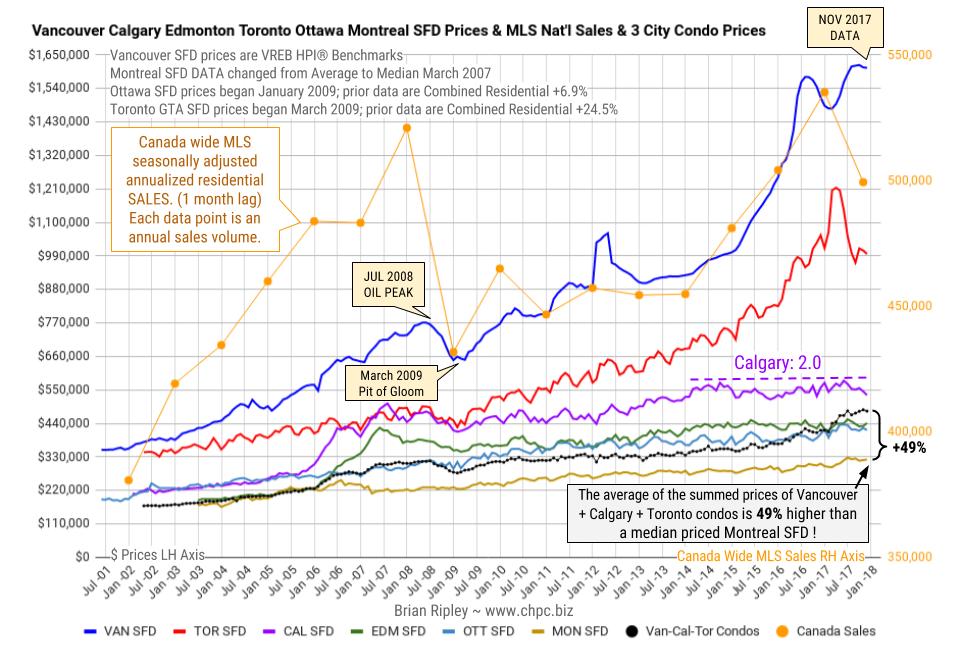Real Estate
According to the latest BLS data, average hourly wages for all US workers in November rose at a stubbornly low 2.5% relative to the previous year, well below the Fed’s “target” of 3.5-4.5%, as countless economists are unable to explain how 4.1% unemployment, and “no slack” in the economy fails to boost wage growth. Another problem with tepid wage growth, in addition to crush the Fed’s credibility, is that it keeps a lid on how much general price levels can rise by. With record debt, it has been the Fed’s imperative to boost inflation at any cost (or rather at a cost of $4.5 trillion) to inflate away the debt overhang, however weak wages have made this impossible.
Well, not really. Because a quick look at US housing shows that while wages may be growing at roughly 2.5%, according to the latest Case Shiller data, every single metro area in the US saw home prices grow at a higher rate, while 16 of 20 major U.S. cities experienced home price growth of 5% or higher: double the average wage growth, and something which even the NAR has been complaining about with its chief economist Larry Yun warning that as the disconnect between prices and wages become wider, homes become increasingly unaffordable.
And while this should not come as a surprise – considering we have pointed it out on numerous occasions in the past – one look at the chart below suggests that something strange is taking place in Seattle, which has either become “Vancouver South” when it comes to Chinese hot money laundering, or there is an unprecedented mini housing bubble in the hipster capital of the world. Also worth keeping an eye on: price appreciation in Sin City has quietly surged in recent months, and in September home prices surged 10.2% Y/Y, the only other double digit price increase in the US after Seattle. Considering that Las Vegas was the epicenter of the last housing bubble when prices exploded higher only to crash, it may be a good idea to keep a close eye on price tendencies in this metro area.
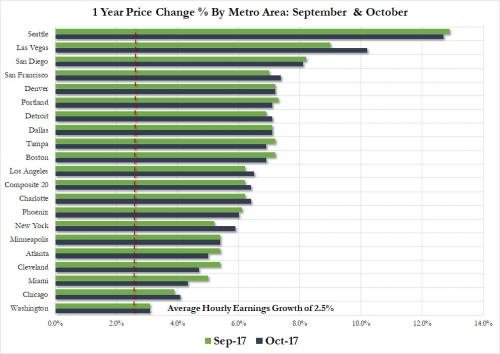
…also from ZeroHedge:
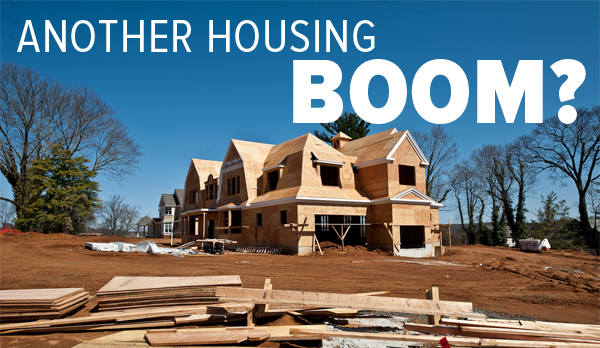
In its November report, mortgage security firm Freddie Mac called 2017 the “best year in a decade” for the housing market by a variety of measures. These include low inflation, strong job growth and historically-low mortgage rates. This assessment is very encouraging, not just for homebuyers and builders and the U.S. economy in general, but also for commodities, resources and raw materials as we head into 2018.
Although past performance is no guarantee of future results, it’s still instructive to look back at how materials performed the last time the U.S. was ramping up housing starts and mortgages. The last housing boom, which peaked in 2006, was accompanied by elevated commodity prices. We could see a return to these valuations over the next couple of years on higher demand, a stronger macroeconomic backdrop and cyclical fundamentals, as shown in the following chart courtesy of DoubleLine Capital:
Speaking on CNBC’s “Halftime Report” last week, DoubleLine founder Jeffrey Gundlach said he thought “investors should add commodities to their portfolios” for 2018, pointing out that they are just as cheap relative to stocks as they were at historical turning points.
“We’re at that level where in the past you would have wanted commodities” in your portfolio, Gundlach said. “The repetition of this is almost eerie. And so if you look at that chart, the value in commodities is, historically, exactly where you want it to be a buy.”
A Wealth of Positive Housing Data
There’s more to support the commodities narrative than cyclicality.
For one, home builders right now are more confident of the future than they’ve been in over 18 years. December’s National Association of Home Builders (NAHB)/Wells Fargo Housing Market Index (HMI) soared to 74, eight points up from the November reading and its highest report since July 1999.
NAHB Chairman Granger MacDonald chalks up the incredible improvement in optimism to “new policies aimed at providing regulatory relief to the business community.” Other contributing factors include low unemployment rates, favorable demographics and a tight supply of existing home inventory.
In addition, new housing starts in November rose to a seasonally adjusted annual rate of 1.3 million, up 3.3 percent from October and a strong 12.9 percent from a year ago.
This is all very constructive (no pun intended), as the market is still trying to recover nearly a decade following the subprime mortgage crisis.
Millennials, the Largest U.S. Generation, Finally Entering the Market
We’ve seen booms and busts in new housing starts over the past several decades, but homeownership rates in the U.S. took a huge blow as a result of the Great Recession. The rate dipped to a 51-year low of 62.9 percent in the second quarter of 2016, indicating buyers, especially first-time millennial buyers, are still struggling to save up for down payments.
Economists with the National Association of Realtors (NAR) note that student debt has played a massive role in delaying homeownership for young people, by as many as seven years on average. When asked how student loan debt has impacted their life decisions, more than seven in 10 millennials (those born roughly between 1980 and 1998) ranked “purchasing a home” as the most affected decision, followed by “taking a vacation.”
Since reaching its low last year, however, the homeownership rate has steadily improved, ending at 63.9 percent in the second quarter of 2017, a three-year high. This leads me to believe that the worst is behind us and that as the economy and labor market continue to improve, so too will demand for new homes. I also have high hopes that the tax cuts President Donald Trump signed into law today will encourage even more millennials, who have until now been sidelined, to join their older cohorts in owning a home.
Time to Add Commodities?
Indeed, all of the conditions appear ripe for another housing boom. Economic growth is on the upswing. The country is at near-full employment. Inflation and 30-year mortgage rates are also historically low.
When we factor in residential fixed investment and housing services, housing as a whole contributes between 15 and 18 percent to national gross domestic product (GDP). That’s a huge slice of the pie. And as I’ve pointed out before, housing has an extremely high multiplier effect. For every home that’s built, 2.97 full-time jobs and $162,080 in wages and salaries are created, according to a 2014 estimate by the NAHB.
Beyond that, increased home demand is good news for resources and raw materials. According to home-construction services firm Happho, for every 1,000 square feet of new housing, nearly 8,820 pounds of steel are required, as well as 400 bags of cement, 1,800 cubic feet of sand and 1,350 cubic feet of gravel and other aggregate. This doesn’t begin to touch on finishers such as brick, paint and tiles, or fittings such as windows, doors, plumbing and electrical. You can see the full infographic by clicking here.
Interested in learning how you can participate in the growing housing market? Unsure how to gain exposure to raw materials and commodities?
All opinions expressed and data provided are subject to change without notice. Some of these opinions may not be appropriate to every investor. By clicking the link(s) above, you will be directed to a third-party website(s). U.S. Global Investors does not endorse all information supplied by this/these website(s) and is not responsible for its/their content.
The S&P GSCI (formerly the Goldman Sachs Commodity Index) serves as a benchmark for investment in the commodity markets and as a measure of commodity performance over time. It is a tradable index that is readily available to market participants of the Chicago Mercantile Exchange.
The Standard & Poor’s 500, often abbreviated as the S&P 500, or just the S&P, is an American stock market index based on the market capitalizations of 500large companies having common stock listed on the NYSE or NASDAQ. The S&P 500 index components and their weightings are determined by S&P Dow Jones Indices.
The NAHB/Wells Fargo Housing Market Index gauges builder perceptions of current single-family home sales and sales expectations for the next six months as “good,” “fair” or “poor.” The survey also asks builders to rate traffic of prospective buyers as “high to very high,” “average” or “low to very low.” Scores for each component are then used to calculate a seasonally adjusted index where any number over 50 indicates that more builders view conditions as good than poor.
Click chart for Larger Version
In December 2017 Toronto metro SFD prices, 8 months since the March 2017 spike and peak price, continued slipping and to date have lost $207,895 or 18%. Vancouver prices are still defying gravity; FOMO and speculative pricing is still on.
Anyone owning a detached house in the scorching hot Vancouver market is sitting on an unredeemed lottery ticket with time running out as buyers hibernate into the seasonal decline. The Bank of Canada interest rate up-moves is thinning the crowd even more.
It remains interesting to note that the combined average sum price of a Vancouver, Calgary & Toronto condo is currently 49% more expensive than a median priced Montreal SFD; last month it was 52% (no typo). It was 51% in APR 2017, 49% in FEB 2017 and 41% in July 2016 at the Vancouver peak. Montreal has more listing inventory available for sale than any of the other 5 biggest metros in Canada and the lowest monthly absorption rate based on total listings and sales.
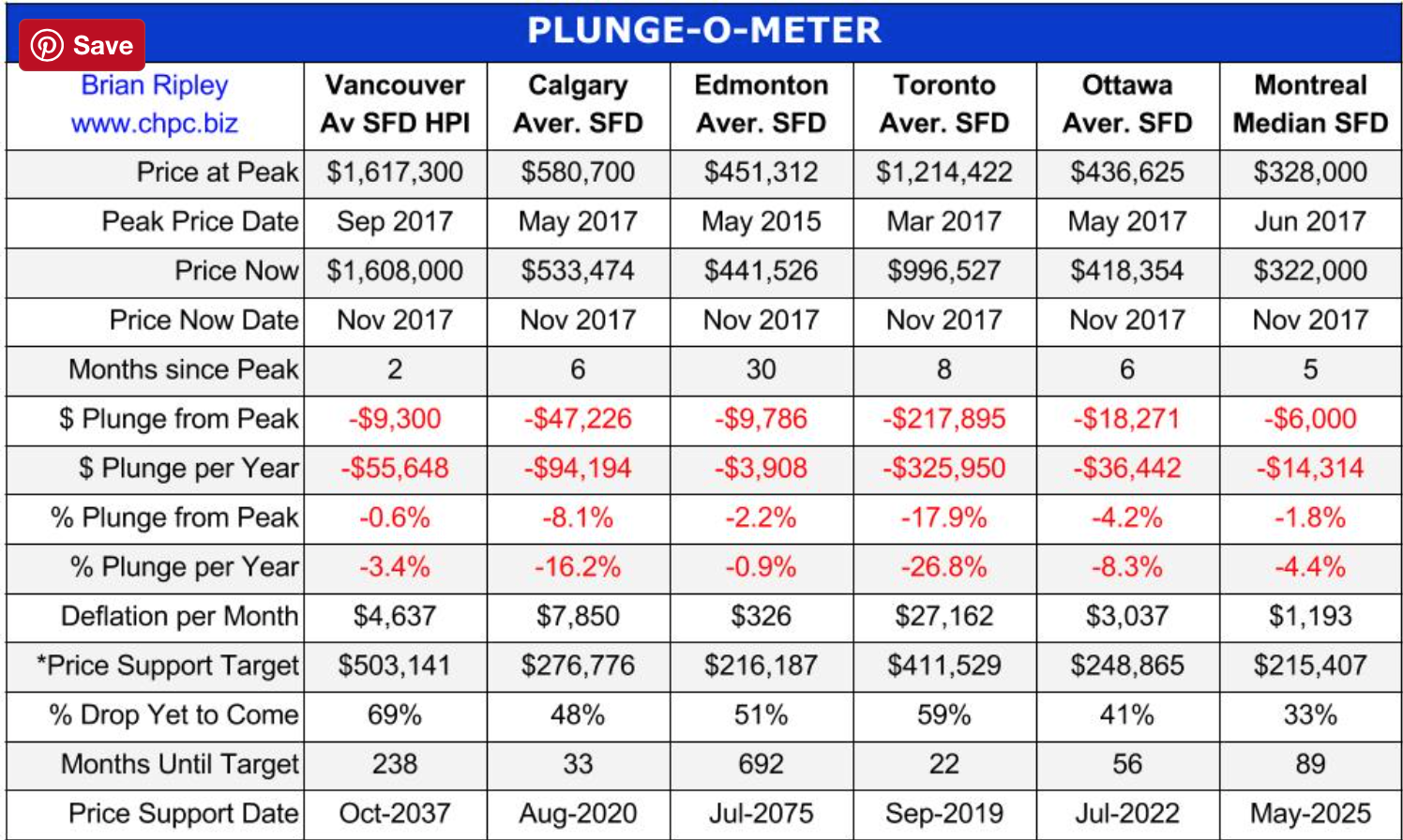
In case you have forgotten the depth and velocity of the previous market reversal when Canadian real estate prices plunged in 2007-2008 (chart); householder equity vanished as follows:
- ’07-’08 Average Vancouver SFD lost $122,900, or 15.9% in 8 months (2%/mo drop)
- ’07-’08 Average Calgary SFD lost $92,499, or 18.3% in 18 months (1%/mo drop)
- ’07-’08 Average Edmonton SFD lost $78,719, or 18.5% in 21 months (0.9%/mo drop)
- ’07-’08 Average Toronto SFD lost $63,867, or 13% in 13 months (1%/mo drop)
- ’07-’08 Average Ottawa Residence lost $25,664, or 8.6% in 6 months (1.4%/mo drop)
- ’07-’08 Median Montreal SFD lost $6,000, down 2.6% in 6 months (0.4%/mo drop)
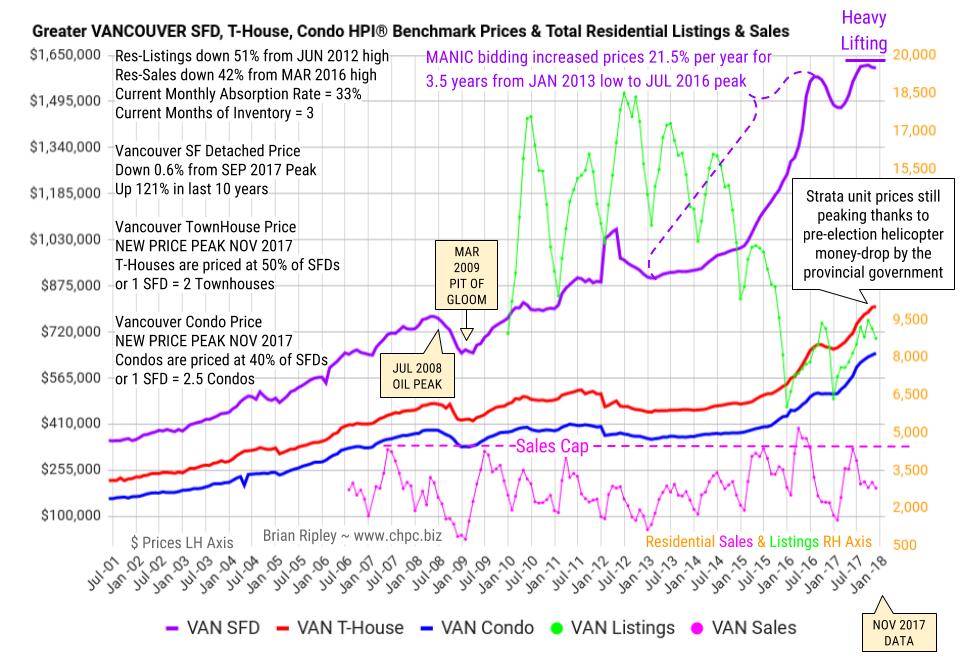
In November 2017, Vancouver detached house HPI prices remained at resistance but strata prices continued ticking up through the July 2016 peak. The manic buying spree moved detached prices up 21.5% per year since the JAN 2013 low and are now up 121% in the last ten years.
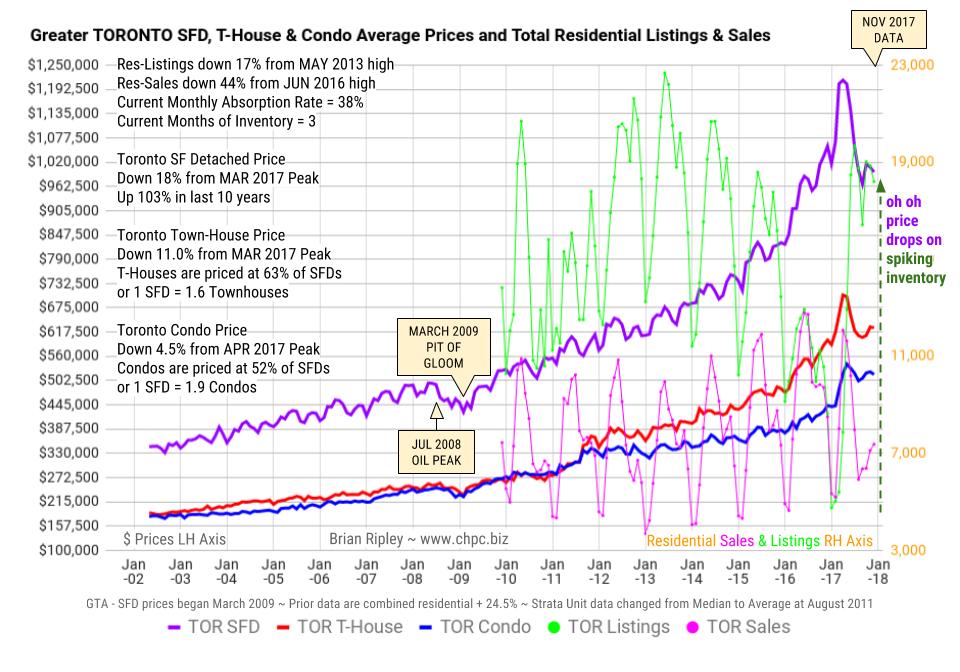
In November 2017 the Toronto housing sector prices remained depressed below their near term showoff spike highs as listing levels spike on seasonally slow sales; that and the winter tendency to hibernate is producing the right side of the “Eiffel Tower” price series.
It seems like investors were writing off the real estate sector entirely.
With the rise of technology used to shop online, work from home and even go to school, real estate has been a hated sector.
But it’s a sector I have been a fan of this year, triggering gains of 15% and 17% in my Pure Income service.
That’s because even though I know the landscape for real estate is changing, I still see the crowds at the malls, the wait times at restaurants and the continued need for hospitals and health care facilities.
So the decline in values recently has looked like an opportunity to me.
But my personal experience or viewpoint doesn’t have anything to do with my recommendation today.
Instead, three separate computer-based buy signals are flashing bullish signals on the real estate sector, and I have a possible triple-digit opportunity for you.
Let me explain.
Three Buy Signals for the Real Estate Sector
Let’s start with the three buy signals on the sector before I give you the opportunity.
The first is the most basic, a price chart of the SPDR Real Estate Select Sector ETF (NYSE: XLRE).

This is showing a possible breakout of a long trend channel.
It may have just had a false breakout, since the price jumped above the trendline, then fell back below it. But this can also hold as a new, steeper uptrend for the exchange-traded fund (ETF). As long as it can hold above its previous peak, around $33.50, prices should continue to climb.
The second is a seasonality chart.

Right now, it is a great time to enter the real estate sector based on a 10-year seasonal analysis of the Vanguard REIT ETF (NYSE: VNQ). I used this ETF because it has data going farther back than the newly listed XLRE in the price chart.
December is clearly the strongest month to be in real estate, and we just bought a real estate investment trust (REIT) in my seasonal service, Automatic Profits Alert, a couple of weeks ago that is already benefiting from this trend.
The third chart is something you may not be too familiar with, but it is a concept I have discussed before called a Relative Rotation Graph™.
If you want to learn more about the concept, you can click here to read more about it.
Basically, it’s the idea that stocks rotate in and out of leading and lagging the market. And there are key turning points, where a sector will shift from lagging, to improving and eventually leading the market.
The real estate sector is at such a point. Take a look:

If you can read the text, you’ll notice it is in the lagging section of the chart. But when an ETF is in that section and turns sharply higher, like XLRE did, that is a sign momentum is shifting and the sector is turning around — which is the exact time we want to jump in.
A Unique Way to Profit
All told, the real estate sector is a solid buy right now.
In my service, I handpick certain stocks to benefit from these trends. For today, I’m going to recommend a unique way to profit, and that’s to buy a call option on the XLRE real estate ETF.
The option we are going to buy is the February 16, 2018, $34 call option.
With this option, we are expecting the ETF to rise as predicted by the three charts above. However, whenever you buy an option, it’s important to remember you can lose everything you paid to buy the option. Even though we have three buy signals, there’s always a chance the trade doesn’t work out, so just keep that in mind.
This option costs roughly $0.55, depending on when you purchase it. Since one contract covers 100 shares, one contract will cost about $55.
Now, I want to highlight that this is not a position that I will be tracking or updating you on, so it will be up to you to pull the trigger to take profits or cut losses.
A good rule of thumb for a trade like this is to sell half of your position at a 50% gain, and manage the second half to either take profits if it begins to fall by about 30% in value, or start to sell the second half once it is above 100%.
For a loss, you can cut it if it falls to a 50% loss.
For the ETF, all we need is it to rise about 4.2% over the next three months to hand us a 100% gain.
Regards,
Chad Shoop, CMT,
Editor, Automatic Profits Alert





